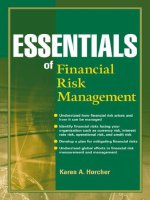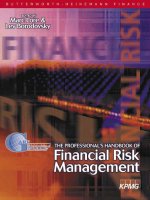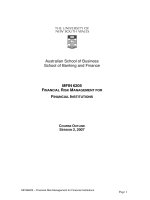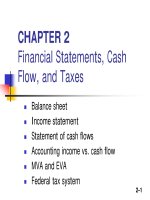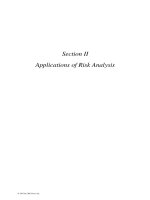Elements of financial risk management chapter 2
Bạn đang xem bản rút gọn của tài liệu. Xem và tải ngay bản đầy đủ của tài liệu tại đây (864.19 KB, 43 trang )
1
Historical Simulation,
Value-at-Risk,
and Expected Shortfall
Elements of
Financial Risk Management
Chapter 2
Peter Christoffersen
Elements of Financial Risk Management Second Edition © 2012 by Peter Christoffersen
Overview
Objectives
•Introduce the most commonly used method for
computing VaR, namely Historical Simulation and
discuss the pros and cons of this method.
•Discuss the pros and cons of the V aR risk measure
•Consider the Expected Shortfall, ES, alternative.
Elements of Financial Risk Management Second Edition © 2012 by Peter Christoffersen
2
Chapter is organized as follows:
• Introduction of the historical simulation (HS)
method and its pros and cons.
• Introduction of the weighted historical
simulation (WHS). We then compare HS and WHS
during the 1987 crash.
• Comparison of the performance of HS and
RiskMetrics during the 2008-2009 financial crisis.
• Then we simulate artificial return data and assess
the HS VaR on this data.
• Compare the VaR risk measure with ES.
Elements of Financial Risk Management Second Edition © 2012 by Peter Christoffersen
3
Defining Historical Simulation
• Let today be day t. Consider a portfolio of n
assets. If we today own Ni,t units or shares of
asset i then the value of the portfolio today is
• We use today’s portfolio holdings but historical
asset prices to compute yesterday’s pseudo portfolio
value as
Elements of Financial Risk Management Second Edition © 2012 by Peter Christoffersen
4
Defining Historical Simulation
• This is a pseudo value because the units of each
asset held typically changes over time. The pseudo
log return can now be defined as
• Consider the availability of a past sequence of m
daily hypothetical portfolio returns, calculated
using past prices of the underlying assets of the
portfolio, but using today’s portfolio weights, call
it {RPF,t+1-τ}mτ=1
Elements of Financial Risk Management Second Edition © 2012 by Peter Christoffersen
5
Defining Historical Simulation
• Distribution of RPF,t+1 is captured by the histogram of
{RPF,t+1-τ}mτ=1
• The VaR with coverage rate, p is calculated as 100pth
percentile of the sequence of past portfolio returns.
• Sort the returns in {RPF,t+1-τ}mτ=1 in ascending order
• Choose VaRPt+1 such that only 100p% of the
observations are smaller than the VaRPt+1
• Use linear interpolation to calculate the exact VaR
number.
Elements of Financial Risk Management Second Edition © 2012 by Peter Christoffersen
6
Pros and Cons of HS
Pros
•the ease with which it is implemented.
•its model-free nature.
Cons
•It is very easy to implement. No numerical
optimization has to be performed.
•It is model-free. It does not rely on any particular
parametric model such as a RiskMetrics model.
Elements of Financial Risk Management Second Edition © 2012 by Peter Christoffersen
7
Issues with model free nature of HS
How large should m be?
•If m is too large, then the most recent observations will
carry very little weight, and the VaR will tend to look
very smooth over time.
•If m is too small, then the sample may not include
enough large losses to enable the risk manager to
calculate VaR with any precision.
•To calculate 1% VaRs with any degree of precision for
the next 10 days, HS technique needs a large m value
Elements of Financial Risk Management Second Edition © 2012 by Peter Christoffersen
8
Figure 2.1:
VaRs from HS with 250 and 1,000 Return Days
Jul 1, 2008 - Dec 31, 2010
Elements of Financial Risk Management Second Edition © 2012 by Peter Christoffersen
9
Weighted Historical Simulation
• WHS relieves the tension in the choice of m
• It assigns relatively more weight to the most recent
observations and relatively less weight to the returns
further in the past
• It is implemented as follows –
• Sample of m past hypothetical returns, {RPF,t+1-τ}mτ=1
is assigned probability weights declining exponentially
through the past as follows
Elements of Financial Risk Management Second Edition © 2012 by Peter Christoffersen
10
Weighted Historical Simulation
– Today’s observation is assigned the weight η1 =
(1- η) / (1- ηm)
– ητ goes to zero as t gets large, and that the weights
ητ for τ = 1,2,...,m sum to 1
– Typical value for η is between 0.95 and 0.99
• The observations along with their assigned weights
are sorted in ascending order.
• The 100p% VaR is calculated by accumulating the
weights of the ascending returns until 100p% is
reached.
Elements of Financial Risk Management Second Edition © 2012 by Peter Christoffersen
11
Pros and Cons of WHS
Pros
•Once η is chosen, WHS does not require estimation
and becomes easy to implement
•It’s weighting function builds dynamics into the
WHS technique
•The weighting function also makes the choice of m
somewhat less crucial.
•WHS responds quickly to large losses
Elements of Financial Risk Management Second Edition © 2012 by Peter Christoffersen
12
Pros and Cons of WHS
Cons
•No guidance is given on how to choose η
•Effect on the weighting scheme of positive versus
negative past returns
•If we are short the market, a market crash has no
impact on our VaR. WHS does not respond to large
gains
•the multiday VaR requires a large amount of past
daily return data, which is not easy to obtain.
Elements of Financial Risk Management Second Edition © 2012 by Peter Christoffersen
13
Advantages of Risk Metrics model
• It can pick up the increase in market variance
from the crash regardless of whether the crash
meant a gain or a loss
• In this model, returns are squared and losses and
gains are treated as having the same impact on
tomorrow’s variance and therefore on the portfolio
risk.
Elements of Financial Risk Management Second Edition © 2012 by Peter Christoffersen
14
Figure 2.2 A:
Historical Simulation VaR and Daily Losses from
Long S&P500 Position, October 1987
Elements of Financial Risk Management Second Edition © 2012 by Peter Christoffersen
15
Figure 2.2 B:
Historical Simulation VaR and Daily Losses from
Short S&P500 Position, October 1987
Elements of Financial Risk Management Second Edition © 2012 by Peter Christoffersen
16
Figure 2.3 A:
Historical Simulation VaR and Daily Losses from
Short S&P500 Position, October 1987
Elements of Financial Risk Management Second Edition © 2012 by Peter Christoffersen
17
18
Figure 2.3 B:
Weighted Historical Simulation VaR and Daily Losses
from Short S&P500 Position, October 1987
Elements of Financial Risk Management Second Edition © 2012 by Peter Christoffersen
Evidence from the 2008-2009 Crisis
• We consider the daily closing prices for a total
return index of the S&P 500 starting in July 2008
and ending in December 2009.
• The index lost almost half its value between July
2008 and the market bottom in March 2009.
• The recovery in the index starting in March 2009
continued through the end of 2009.
Elements of Financial Risk Management Second Edition © 2012 by Peter Christoffersen
19
Figure 2.4: S&P 500 Total Return Index:
2008-2009 Crisis Period
Elements of Financial Risk Management Second Edition © 2012 by Peter Christoffersen
20
21
Evidence from the 2008-2009 Crisis
• The 10-day 1% HS VaR is computed from the 1-day
VaR by simply multiplying it by
• Alternative to HS is the RiskMetrics variance
model
• 10-day, 1% VaR computed from the Risk- Metrics
model is as follows:
Elements of Financial Risk Management Second Edition © 2012 by Peter Christoffersen
22
Evidence from the 2008-2009 Crisis
• where the variance dynamics are driven by
Difference between the HS and the RM VaRs
•The HS VaR rises much more slowly as the crisis gets
underway in the fall of 2008
•The HS VaR stays at its highest point for almost a
year during which the volatility in the market has
declined considerably
•HS VaR will detect the brewing crisis quite slowly
and will enforce excessive caution after volatility
drops in the market
Elements of Financial Risk Management Second Edition © 2012 by Peter Christoffersen
Figure 2.5: 10-day, 1% VaR from Historical
Simulation and RiskMetrics During the
2008-2009 Crisis Period
Elements of Financial Risk Management Second Edition © 2012 by Peter Christoffersen
23
24
Evidence from the 2008-2009 Crisis
• The units in figure above refer to the least percent of
capital that would be lost over the next 10 days in
the 1% worst outcomes.
• Let’s put some dollar figures on this effect
• Assume that each day a trader has a 10-day, 1%
dollar VaR limit of $100,000
• Thus each day he is therefore allowed to invest
Elements of Financial Risk Management Second Edition © 2012 by Peter Christoffersen
25
Evidence from the 2008-2009 Crisis
• Let’s assume that the trader each day invests the
maximum amount possible in the S&P 500
• The daily P/L is computed as
Elements of Financial Risk Management Second Edition © 2012 by Peter Christoffersen

